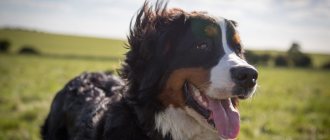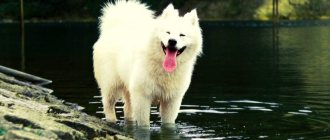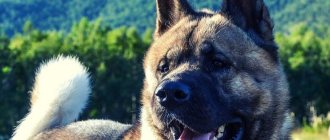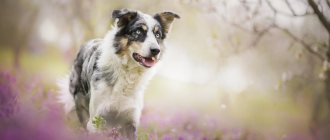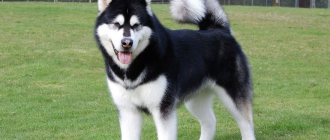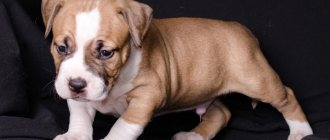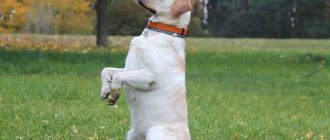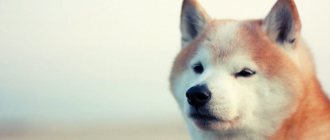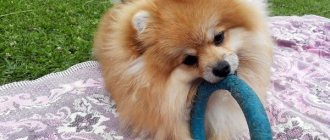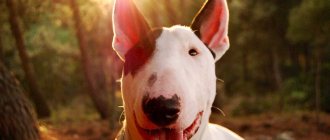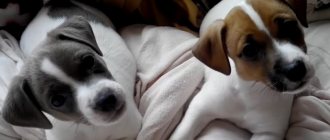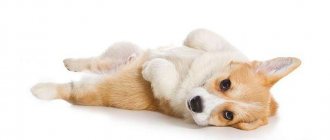Raising a dog is about developing correct behavior. This is the basis for successful training. Training is a set of activities aimed at training specific teams. It is necessary to start raising a puppy from the very first days of his appearance in the house. If you work with your pets from a very early age, then you are on the right track.
The Miniature Pinscher breed was originally bred in Germany to hunt rats in houses and stables. Many people think that the Miniature Pinscher was created by breeding Dobermans to gradually smaller sizes, and indeed, the Miniature Pinscher looks similar to the Doberman. However, the miniature pinscher is a separate and much older breed of dog.
- Country of origin : Germany
- Height at withers : male: 25–30 cm, female: 25–28 cm
- Weight : male: 4–5 kg, female: 3.5–4 kg
- Lifespan : 13-15 years
- Use : companion dog, rat catcher
- Other names : miniature pinscher, miniature pinscher
When to start training a dog
As soon as a miniature pinscher puppy appears in your home, immediately begin to build a relationship with him. From the first day it is necessary to provide him with everything he needs: bowls for water and food, collar, leash, bed, suitable food, toys and of course treats. You need to give him a lot of attention so that he feels safe and begins to trust you. From a very early age, a miniature pinscher puppy must be introduced to commands. In addition, in the first months it is necessary to study commands both at home and on the street. First, the puppy must remember its name. We wrote how to choose a suitable nickname in one of our articles. The name should be short, easy to remember and the dog should be called only by it. When the pet has already mastered its name and finally begins to respond, then we move on to commands. By the 3rd month he should master the following commands: “Ugh!”, “Come to me!”, “Place!”, “Nearby!” and “Fetch!” (optional). Then you can move on to the rest, of course, if you need them.
Friend of the whole family
The main purpose of modern miniature pinschers is as a companion. He will equally find something to do on a walk with the elderly and with children. At the same time, it easily adapts to weather conditions, and only in the most severe frosts will you have to put a blanket or overalls on your pet. The rest of the time, his ebullient energy will not allow him to freeze in either rain or snow.
However, the nature of the miniature pinscher is such that the baby needs to be on the move. If you force him to sit or stomp around next to his owner while he communicates with friends, he will quickly freeze.
They need constant movement and fun games like air!
It can withstand long trips by public transport or car with dignity, especially if it receives enough attention during the trip. Hysteria and nervousness are not characteristic of most representatives of this breed. They can spend long hours without being intrusive, waiting for the owner to give them a minute of his time.
However, you should not bring a miniature pinscher into a family with small children: a fragile and non-aggressive dog can suffer from active child love. But starting from about 7-8 years old, children are already able to not only properly handle a miniature pet, but also go on bike rides with it, learn agility, or enter the show ring.
How to raise a miniature pinscher puppy
If you train your pet correctly, then over time you will get an obedient dog that will follow all commands and delight you every day. Experts believe that several factors may influence the miniature pinscher’s susceptibility to following various commands:
- pet's temperament - the speed of the pet's reaction to stimuli, both positive and negative;
- character - how exactly the dog resists various unpleasant influences;
- obedience - the dog’s ability to accept human leadership;
- vigilance - the speed with which the dog notices potential danger, both in relation to itself and in relation to the owner;
- aggressiveness - the pet’s ability to react hostilely to potential danger;
- curiosity - interest that is developed when a dog feels, hears and sees something;
- sociability - the ability to interact with people;
- possessiveness is the interest shown by animals in certain objects, for example toys.
How quickly your dog will learn commands depends on what specific traits predominate in the character of a miniature pinscher puppy. By paying attention to the character traits of your animal, you can find an approach to it and adjust its behavior in certain situations.
- Eagerness will get you nowhere . You should not try to teach your miniature pinscher puppy all the commands at the same time; you need to learn the commands one by one. You need to have patience and act methodically. You should not scold your pet at the moment when he makes mistakes, and when he succeeds in something, then the pet should be encouraged.
- Don't hit . It is prohibited to use physical punishment against a pet. You should limit yourself to variable intonation, but avoid shouting. After a miniature pinscher puppy turns three months old, it is allowed to use a light spank as punishment while saying the phrase “Ew.” It is necessary to punish immediately when the animal commits an offense, and not after it, since the animal simply will not understand what exactly it was punished for.
- Subsequence . The main goal is to ensure that the pet follows the command the first time. Commands should be pronounced clearly and in an even voice so that the dog understands and obeys you. All family members should be involved in raising the dog, but they must act together. It is forbidden to allow situations in which you scold the puppy, and another family member praises him or simply does not pay attention.
- Pamper . Remember to reward your Miniature Pinscher puppy with a variety of treats and praise when he has done what is asked of him.
What to feed – natural food or industrial food
The diet of an adult Pinscher should be well balanced. Gradually the percentage of meat products is reduced. You need to add more fish, greens, eggs and cottage cheese to the food. You can offer your dog fermented baked milk, yogurt, kefir.
By this time, Pinscher is already making his preferences clear. However, you shouldn’t follow his lead. Instead of a beef bone that he may chew on constantly, offer raw vegetables or fruits. A piece of a green hard apple cleanses the teeth, but raw beets or carrots do an excellent job of cleansing the intestines.
Basic commands
You will use some commands more often, others less often. But they will still come in handy to easily interact with the miniature pinscher and even protect him in various situations.
- Aport. One of the most difficult teams. Many people perceive it as very easy and simple, but with many dogs you will have to work hard. This skill is used for other exercises: searching, searching, selecting an item and many others. Usually they are all used in service. When working out a command, “Aport” and “Give” are used, and a gesture is also used.
- Give. On the command “Give” the dog must give up the object.
- Lie. A connecting command that needs to be learned for other commands. In addition, it will not interfere at home or on the street.
- To me. You will need to use this command quite often. So start with it immediately after your Miniature Pinscher puppy has learned his name. Never call the dog to punish, and do not scold if it comes on its own, even after mischievousness before it. This behavior on your part may alienate the animal.
- Place. A puppy or an adult dog must clearly know where his place is located. He can sleep anywhere, if you allow it, of course, but he must know this command. You can use it outside the home, marking the place with a leash or your favorite toy.
- Near. It is possible to teach your pet the “Near” command at any age, be it an adult dog or a small puppy. When you move to a new home, you should immediately think about training your puppy.
- Sit. One of the very first commands that a miniature pinscher puppy should learn.
- Stand. The command is useful in everyday life, for example, for combing a dog.
- . The prohibiting command is one of the most mandatory and taming it begins from the first day the puppy appears in the house. Requiring the command “Fu!”, “No!”, “No!” - immediately stop the unwanted action.
Training
Most owners note their high intelligence, and some claim that they “read the thoughts” of their owner. Raising a miniature pinscher is not a difficult process: despite their small stature, they easily master equipment on the training ground and are able to learn many tricks. Even those who got a dog for the first time can cope with their training.
But this is a thinking breed that instantly senses pliability and weakness of character, and if the owner is inactive, it can become a domestic tyrant, despite its small size.
Miniatures need a firm hand from the owner, but rudeness during training is completely unacceptable. The basis of training should be love, patience and mutual understanding, then the intelligence of the miniature is fully revealed.
Miniature Pinschers have an excellent sense of smell, they are suspicious of strangers, extremely attentive to what is happening and can be excellent guards. No wonder they are called mini Dobermans...
In sports, they not only “try”, they also succeed! And first place in agility is not uncommon.
Raising a dog
Education is the process of shaping the behavior of a miniature pinscher acceptable to the owner, when this behavior is not regulated by commands.
During upbringing, a dog develops relationships with its owner, family members, passers-by, behavior in the house, on the street, and relationships with other dogs. The training process begins immediately when the dog first appears in the house and continues throughout the dog’s life. Regardless of the dog's breed, it must be trained. Just as people do not like ill-mannered people, dogs should also know what is allowed and what is not allowed. Raising a dog is a rather complex process, which is not limited to learning just a few commands. The main goal of education is that the dog should become pleasant to talk to. In addition, it must be manageable at some points, otherwise it will be very difficult for the dog owner. In the broadest sense of the word, dog training is about teaching the dog commands such as “Bad” and “No”. But besides this, the dog must know what is good and what is bad, even in those moments when the owner is not around. Some believe that the miniature pinscher only understands commands, but cannot generalize. Only those who, as a rule, never had dogs, and studied them only in laboratory conditions, in which dogs were not able to show their full potential, are convinced of this, as well as those who, due to their personal qualities, were unable to establish a relationship with pet. In real life, the miniature pinscher is a pack animal and therefore, like any other pack animal, needs to communicate with members of its family. In this situation, the dog’s family members are people. It is quite stupid to think that if a dog caresses you, this means that his skin is itching. In order for a dog’s nervous system to function normally, it needs affection, love, communication, and praise. In addition, so-called “inhibiting factors” are required, because if the dog is allowed everything, then this will not lead to anything good. When raising a miniature pinscher puppy, you should pay attention to the genetic characteristics of the breed. A family is a pack in which there must be a leader, in this case the leader is a person. The leader punishes, plays, feeds, caresses, praises and scolds. All other members of the owner's family are ranked by rank. At that moment, while the puppy is small, all other family members are senior to him. However, in the process of growing up, around the age of one year, the dog begins to look for its place in the hierarchical pyramid. Naturally, she will try to take the step that is as high as possible. She can do this with the help of force, in the case of large dogs, or with the help of cunning, as small dogs do. The more ill-mannered the dog is, the more difficult this process will be. If the owner from the first days shows his pet that the one who has the power is right, then he will turn out to be a frail neurotic or an evil beast with whom you will hardly communicate with joy. A miniature pinscher puppy must understand that he must obey people, since they love him, feed him, and raise him. Understand that prohibitions are not the whim of the owner, but a way to protect everyone from trouble. The main influence on the dog should be the voice. From the first days of being in your home, the puppy must realize that you love him, and if you raise your voice, then this means that he is doing something wrong. One of the best incentives for a pet is considered to be a treat, which should be given out for good behavior and listening to commands. Training and education of the miniature pinscher
Industrial feed classes
Feeds are divided into classes.
- Economy - low quality, does not contain useful additives.
- Premium - the composition actually contains the necessary minerals and vitamins, as well as protein.
- Super premium – included׃
- eggs;
- fat;
- vitamins and minerals;
- meat;
- vegetables;
- cereals.
When buying food of this level, you do not need to worry about the health of your pinscher.
You should not skimp on your dog and buy low quality food. If it is not possible to purchase super premium, then it is better to use a lower class. Premium is made from natural high-quality products and contains the necessary additives.
Advantages and disadvantages
The Miniature Pinscher is a miniature but agile breed that is not suitable for couch potatoes or people in poor health. These dogs require active play and physical exercise, but they are unpretentious in food and living conditions, almost do not shed, and can be kept even in a small apartment. The main advantages and disadvantages of the breed are analyzed in detail in the table.
Table - Pros and cons of the miniature pinscher dog breed
| pros | Minuses |
| - Can be kept in a regular apartment; - endurance and good health; - developed protective instinct; - unproblematic wool; - rare shedding; - unpretentiousness in food; - learning ability | - They get cold in winter, they need clothes; - small for a watchman, but too active for decoration; - need regular physical activity; - require serious education; - may show willfulness or try to dominate the owner |
Diseases and breed defects
The most common shortcomings and disqualifying defects of the miniature pinscher are:
- coarse or overly light build;
- short or high legs;
- heavy or rounded skull;
- folding on the forehead;
- short, pointed or narrow muzzle;
- direct bite;
- light, too small or too large eyes;
- low-set or very long ears;
- ears with different types of set;
- the presence of a dewlap;
- an excessively long, tight or soft back, as well as a hunchback;
- sloping croup;
- ambling or prancing step;
- rare wool.
A dog of this breed should not be cowardly, aggressive, angry or nervous, and should not have an underbite or underbite, or misalignment of the jaw. The most common hereditary and breed diseases of the miniature pinscher include:
- urolithiasis disease;
- tracheal collapse;
- diabetes;
- shoulder dislocation;
- Legg-Calvé-Perthes disease
- pannus;
- progressive degeneration of the retina;
- dystrophy of the ocular cornea;
- entropion of the eyelid;
- glaucoma and cataracts;
- epileptic seizures;
- congenital deafness.
Polytrauma, which develops when the pet falls from a great height, is quite common in miniature pinschers. Among other things, the miniature pinscher must be protected from cold and drafts, and to maintain health, it is necessary to provide the pet with systematic preventive veterinary examinations, timely vaccination, as well as long walks with outdoor games.
Walking with a Pinscher
Long walks and bike rides are a great joy for a miniature pinscher; they allow him to fully express his curiosity and activity, as well as spend a lot of time with his owner. Having splashed out his energy, the baby will behave calmer in the apartment.
A dog stuck at home can look for adventure by jumping on tables and window sills, casually knocking objects in its path onto the floor, gnawing furniture and wires.
In winter, if the temperature drops below -20 degrees, the miniature pinscher will need warm clothes. At the same time, you should not reduce your walking time, because his irrepressible energy does not depend on the time of year. In spring and autumn, in damp weather accompanied by wind, the baby will also need windproof overalls that will protect against colds. The combination of moisture and wind is more dangerous than severe frost, so on such days it is better to reduce the time spent outside.
During estrus, it is important to wear diapers at home or just panties on the bottom: bitches are also big fidgets, and it happens that they do not have the perseverance to carefully lick the discharge. Therefore, you need mechanical protection while your baby is empty.
Basic Rules
Most dog breeders make a huge mistake when training their dogs at home. They wait to start training the dog until it is 6 months old. It is necessary to train from the first days when the puppy appeared in the apartment or house. The success of parenting is influenced by three important rules that should be followed:
- Encouragement
. In order for the dog to be more willing to complete tasks during training, it is necessary to provide motivation. The pet should receive a well-deserved reward after a successful trick. The prize can be in the form of a pat or a treat. It is enough to give a piece of cheese or a couple of pieces of dry food pellets. - Rest
. If you exhaust yourself with training, the puppy will quickly get tired. This, in turn, will affect the quality of the tasks performed. Therefore, the pet must rest from time to time. For these purposes, a training schedule is drawn up. - Mood
. New commands must be done in a playful manner. Therefore, you should not yell at your pet if it is difficult for him to master new stages of training. And you can’t even hit him. Over time, the puppy will begin to cope with the task.
The success of training is influenced by the workload of the puppy, the breed of dog and the length of time of training. After some time, your four-legged friend will easily demonstrate new tricks.
Important!
For the process to proceed smoothly, it is necessary to provide the dog with a trusting and friendly relationship on the part of the owner. This is the only way to achieve results.
History of the breed
Minipins
, as the dog of this breed is also called, have a rich history dating back to the distant fifteenth century. It was from this period that mentions began in the paintings of famous artists about the brave assistants of grooms and rat catchers. Dogs are distinguished by their speed of reaction, agility and hunting abilities.
In addition to their function as rat catchers and stable guards, dogs are mentioned as faithful companions of royal and noble carriages. At that time, it was considered the height of prosperity and luxury if a carriage or cart was accompanied by the ringing and piercing bark of these animals. You can often see the royal couple with a mini pet proudly in their arms or near them.
Breed Features
miniature pinschers
– are unique in their kind. Such dogs with a huge soul, heart and inner world. Males are active guys whose energy spills over the edge. They infect you with optimism and the desire to move. But along with their activity, they are wayward and characteristic. If you do not start training your dog in time, serious discipline problems may arise in the future.
Bitches, on the contrary, are more tender and sensual. For them, the relationship with the owner and his attention are more important than four daily walks and sports activities and training. In addition, it is easier for girls to be accustomed
to
a home
toilet
or diaper, and then the need for daily walking disappears by itself.
But this does not mean that you can completely lock your dog within four walls. In addition to the fact that the animal will lose physical shape and gain excess weight, serious health problems may also arise. By the way, the miniature pinscher weighs
neither more nor less - from four to six and a half kilograms.
As a rule, male miniature pinschers weigh
more than females due to their more developed muscles.
Photo gallery
miniature pinscher
- This is an ideal dog breed for those who are amazed by the gracefulness, agility and aristocracy
of the Doberman Pinscher
, but, alas, cannot afford such a large dog.
Miniature Pinschers
are essentially a smaller
version of the Doberman Pinscher
, not much different from their larger counterparts.
They are equally energetic and active and love long and active walks. They have very developed muscles and a fighting disposition. Despite their small size, these dogs are always ready to stand up for themselves and their owner, they are unusually curious and always try to defend their place in the sun. If you decide to get a dog of this breed, you need to know its characteristics, the care required and how much a miniature pinscher should weigh
as a teenager and as an adult.
